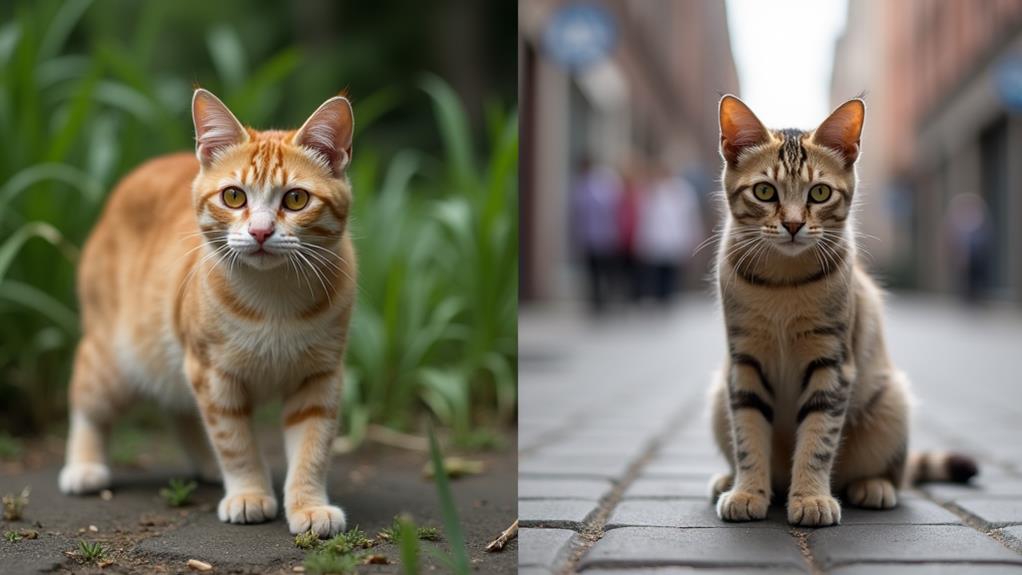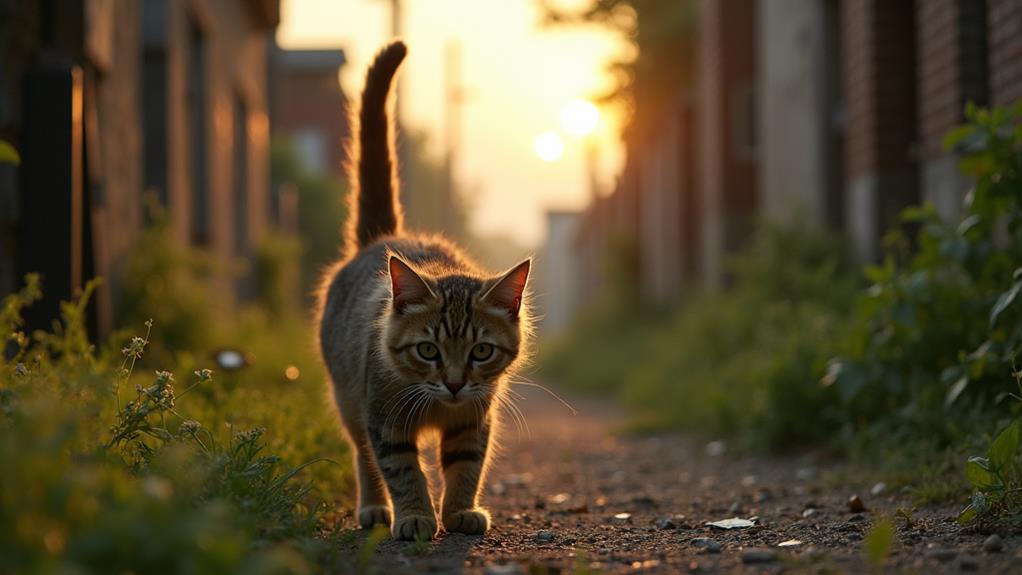How to Tell if a Cat Is Feral or Stray: Key Differences

To tell if a cat is feral or stray, observe its behavior and physical traits. A stray cat is usually friendlier, may approach humans, and vocalizes for attention. It often has a well-groomed coat, suggesting previous care, and might wear a collar. Feral cats avoid humans, appearing wary or aggressive, and are often silent. Their coats often look unkempt, and signs of malnourishment are common. Socialization levels differ too; stray cats can adapt to indoor life, while feral cats typically remain wild. These insights will guide you in understanding these key differences more deeply.
Signs of a Stray Cat
When trying to identify a stray cat, you'll notice they tend to be friendly and may approach humans for attention. This behavior suggests previous socialization with people, making them more open to human interaction. Stray cats often display vocalization behavior, such as meowing, which indicates they're seeking interaction or help from you. This vocalization is a sign they're comfortable around humans and are reaching out for companionship or assistance.
You'll also observe that stray cats are usually well-groomed, indicating they've had regular access to care and food. This grooming suggests they haven't been away from human environments for long. Furthermore, some may still wear collars or identification tags, which can help you locate their owners if they are lost. When a stray cat approaches you, they might initially show signs of anxiety or fear, but with patience, they can quickly adapt to indoor life once again.
Their behavior often includes seeking human companionship, showing they miss the presence of people. With time and patience, these friendly felines can become comfortable in a home environment, making them wonderful companions once they settle in.
Identifying a Feral Cat
While stray cats often seek human interaction, feral cats are a different story. They lack positive human contact and are typically wary of people, often displaying avoidance behaviors. When you approach a feral cat, it will likely flee or show signs of aggression, setting them apart from the more approachable stray cats. Unlike their stray counterparts, feral cats are usually born outdoors and have minimal exposure to domestic life, making them resistant to indoor living conditions and the idea of domestication.
When identifying a feral cat, look for certain markers. For instance, ear-tipping is a common identifier, indicating the cat has been neutered through a Trap-Neuter-Return (TNR) program. This is a vital part of managing feral cat populations, as it helps prevent overpopulation. While adult feral cats are generally unsuitable for domestication, kittens born to feral mothers can be socialized and adopted if caught before four months of maturity. This window is essential, as it determines their ability to adapt to human care. Recognizing these characteristics can help you differentiate between feral and stray cats, ensuring the right approach to managing and caring for them.
Behavioral Differences

Behavioral differences between stray and feral cats are often stark and immediately noticeable. Stray cats usually exhibit friendly behavior towards humans, seeking interaction and showing a willingness to approach. They might vocalize, such as meowing, to communicate with you, indicating comfort in human presence. These cats often appear clean and well-fed, suggesting previous social bonds with people. In contrast, feral cats tend to avoid humans altogether. They may flee or hide when approached and are typically silent, avoiding any vocal interaction. Their body language is often fearful, displaying resistance to touch or handling.
When observing stray cats, you'll notice they may allow gentle handling, showing signs of relaxation. They can often be re-socialized, adapting well to indoor living due to their prior human interactions. Feral cats, however, lack this socialization, making them unlikely to adapt to domestic environments. They survive independently, which often results in unkempt appearances and potential malnutrition. Understanding these behavioral cues will help you determine if a cat is a stray looking for companionship or feral, preferring to maintain its distance from humans. Recognizing these differences is essential for appropriate interaction and care.
Physical Appearance Clues
Understanding the behavioral differences gives you a solid foundation in identifying stray and feral cats, but physical appearance offers supplementary clues. Noticing these differences can help you determine if a cat is feral or stray. Here are some key indicators to look for:
- Grooming: Stray cats usually have clean, well-groomed coats, as they are used to regular human care. In contrast, feral cats often appear unkempt or dirty due to their independent outdoor lifestyle and lack of grooming.
- Ear-tipping: This is a significant form of identification for feral cats who have been part of a Trap-Neuter-Return (TNR) program. An ear-tipped cat has a flat or notched ear, while stray cats typically do not have this feature.
- Body Weight: Stray cats often maintain a healthy body weight, indicating they are well-fed. Feral cats, however, can appear malnourished if they struggle to find consistent food sources.
- Territorial Behavior and Injuries: Feral cats, especially males, may show signs of fighting or injuries due to territorial behavior. Stray cats are generally less likely to bear such marks.
Socialization Levels

Socialization levels are a key factor in distinguishing between stray and feral cats. Stray cats are often more socialized and display friendly behavior, actively seeking human interaction. You might notice stray cats vocalizing, approaching people, and showing signs of trust. In contrast, feral cats generally avoid human contact and exhibit fearful or aggressive behavior, often remaining silent and retreating when you come near.
Understanding these socialization levels is essential. Stray cats can often be rehabilitated with patience, adapting to indoor life once they feel safe. This adaptability makes them more suitable for adoption. On the other hand, feral cats, due to their lack of early socialization, have a much lower chance of adjusting to a domesticated environment. They are unlikely to become comfortable around humans, making them better suited to living in managed colonies or the wild.
Kittens born to feral mothers present an opportunity. If captured before four months of maturity, they can be socialized and introduced to human interaction, increasing their chances of becoming friendly pets. Misidentifying a stray as feral can lead to unnecessary euthanasia or poor management, highlighting the importance of correctly evaluating a cat's socialization level.
Tips for Handling Cats
Knowing if a cat is stray or feral helps determine the best approach for handling them. When dealing with stray cats, use calm movements and gentle vocalizations to build trust. Stray cats often seek human interaction despite their initial anxiety. In contrast, feral cats require a different approach. It's best to observe them from a distance, as they may exhibit fearful behaviors or even aggression if they feel threatened.
Assessing body language is vital in understanding their state. Stray cats might show friendly postures like rubbing against objects, signaling openness to human interaction. Feral cats, however, may crouch or hide to avoid contact, indicating a need to maintain space.
Here are some tips for handling cats:
- Use calm movements: Approach stray cats quietly to build trust, while keeping your distance from feral cats.
- Observe body language: Identify friendly postures in strays and fearful behaviors in ferals.
- Offer food and water: Encourage trust with stray cats, but avoid feeding feral cats directly.
- Explore local resources: Contact animal control or shelters for assistance in managing stray and feral cats effectively.
These strategies guarantee safe and effective interactions with both stray and feral cats.
Community Support Resources

In view of the challenges posed by stray and feral cat populations, community support resources play a vital role in managing these animals humanely and effectively. Organizations like Feral Friends Network and Alley Cat Allies offer invaluable resources to address both feral and stray cats in your neighborhood. They advocate for humane treatment through strategies like Trap-Neuter-Return (TNR), which improves the health and welfare of feral cats while controlling their numbers.
Local shelters and rescue groups also contribute greatly by providing spay/neuter services and adoption initiatives. These programs not only help reduce the stray cat population but also increase the chances of finding loving homes for adoptable cats. By participating in these initiatives, you can actively contribute to creating a balanced ecosystem where both humans and cats coexist peacefully.
Community engagement is vital for the success of these efforts. Advocacy groups encourage you to get involved in policy development and promote the humane treatment of all cats. You can attend workshops, access informational materials, or volunteer with local organizations to learn effective cat care and management techniques. By tapping into these community support resources, you help guarantee cats become valued members of your community.




